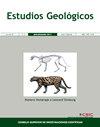IF 0.8
4区 地球科学
Q3 GEOLOGY
引用次数: 2
摘要
Algar do Carvao(一个成因复杂的坑)和Branca Opala(一个熔岩管洞穴)的火山洞穴与特塞拉岛上的其他洞穴不同,它们的洞穴主题仅由蛋白石组成。在火山洞穴中发现的这类洞穴化石表明,二氧化硅的成因可能与热液活动有关。本研究的目的是测定δ¹⁸O SMOW和δ d SMOW中岩浆岩的同位素组成,以确定其地球化学特征和形成条件。来自Algar do Carvao坑的研究样本是在陆地条件下形成的钟乳石和流石/砾石,而来自Branca Opala熔岩管的研究样本被定义为水下二氧化硅叠层石。两个岩洞的溶洞元素dD值较为相似(Branca Opala为- 102.0±10.5‰,Algar do Carvao为- 103.7±11.1‰),可以推测溶洞中石英沉积的流体可能相似。此外,δ¹⁸O SMOW数据表明,Algar do Carvao岩石层的δ¹⁸O SMOW值为39.4±0.3‰,高于Branca Opala叠层石(δ¹⁸O SMOW 35,2±0.8‰)。影响蛋白石A的成岩作用可以部分解释观察到的差异。然而,其他遗传因素也有影响,例如Algar do Carvao钟乳石是在水下条件下在蒸发过程的影响下形成的,而Branca Opala洞穴是在水下条件下形成的。然而,也有可能,形成Branca Opala洞穴的水比形成Algar do Carvao钟乳石的水要温暖10.7°C。本文章由计算机程序翻译,如有差异,请以英文原文为准。
Composición isotópica (δ¹⁸ O y δD) de espeleotemas silíceos en las cuevas volcánicas de Algar do Carvão y Branca Opala (Isla Terceira, Azores, Portugal)
The volcanic caves of Algar do Carvao (a pit with a complex genesis) and of Branca Opala (a lava-tube cave), differ from other caves on the island of Terceira by having speleothems composed only by opal. This kind of speleothems, in volcanic caves, suggests that the silica origin can be related to hydrothermal activity. The objective of this study is to determine the speleothem isotopic composition in δ¹⁸O SMOW and δD SMOW to determine their geochemical signature and conditions of formation.
The studied samples from Algar do Carvao pit are stalactites and flowstones/gours that have been formed in subaerial conditions, while those from the Branca Opala lava tube have been defined as underwater silica stromatolites.
dD data of speleothems from both caves are relatively similar (−102.0 ± 10.5‰ in Branca Opala and −103.7 ± 11.1‰ in Algar do Carvao) and it can be assumed that the fluids involved in the silica deposition may be similar. Moreover the δ¹⁸O SMOW data show that the Algar do Carvao speleothems have higher values (δ¹⁸O SMOW 39,4 ± 0,3‰), relatively to the Branca Opala stromatolites (δ¹⁸O SMOW 35,2 ± 0,8‰). The diagenesis that affected the opal A may explain, in part, the observed differences. However, other genetic factors are also influencing such as the fact that Algar do Carvao stalactites are formed in sub aerial conditions, under the influence of evaporation processes, while Branca Opala speleothems were formed in underwater conditions. However, it is also possible, that the water that originated the Branca Opala speleothems was 10,7 °C warmer than the water that formed the Algar do Carvao stalactites.
求助全文
通过发布文献求助,成功后即可免费获取论文全文。
去求助
来源期刊

Estudios Geologicos-Madrid
GEOLOGY-
CiteScore
1.40
自引率
14.30%
发文量
6
审稿时长
>12 weeks
期刊介绍:
Since 1945 Estudios Geologicos publishes original research works, as well as reviews, about any topic on Earth Sciences.
Estudios Geologicos is published as one yearly volume, divided into two half-yearly issues. It is edited by the Spanish National Research Council (Consejo Superior de Investigaciones Científicas, CSIC) at the Instituto de Geociencias (CSIC-UCM).
Estudios Geologicos provides free access to full-text articles through this electronic edition. Accepted articles appear online as "Forthcoming articles" as soon as the galley proofs have been approved by the authors and the Editor-in-Chief. No changes can be made after online publication.
 求助内容:
求助内容: 应助结果提醒方式:
应助结果提醒方式:


